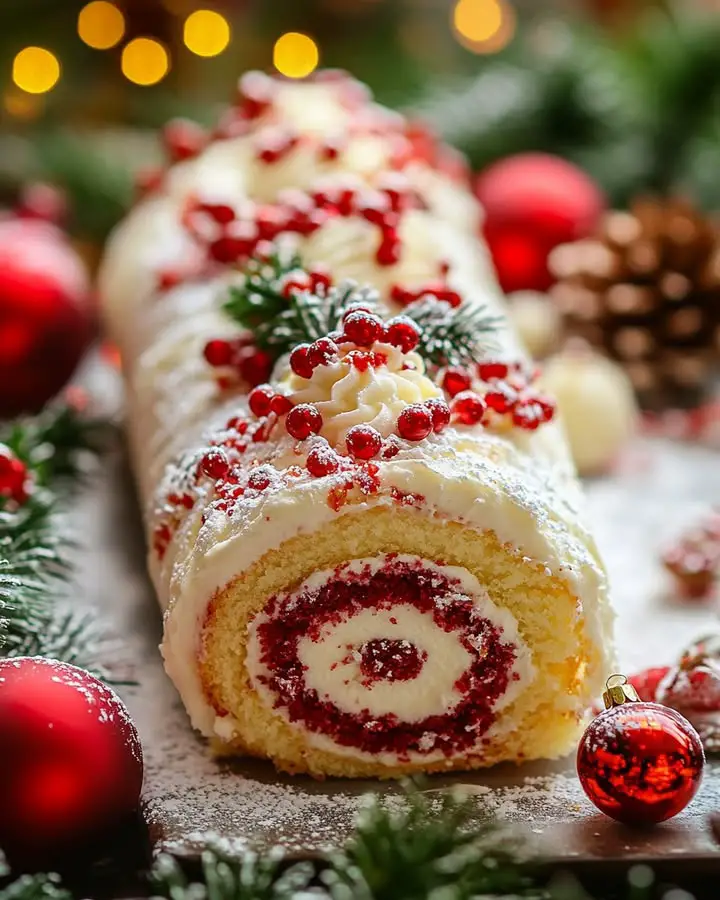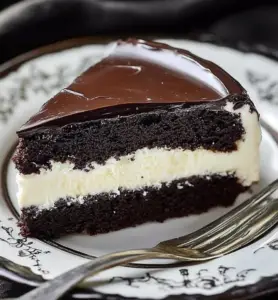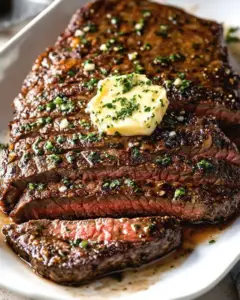Best Christmas Roll Cake: A Festive Delight!
This Christmas Roll Cake is the perfect festive dessert to impress your guests. With its light sponge, creamy filling, and holiday-themed decorations, it brings joy to any celebration. Moreover, the combination of flavors and textures makes it a standout dish on your holiday table. Whether you serve it at a family gathering or a holiday party, this cake will steal the show.
Imagine slicing into a beautifully rolled cake with swirls of rich cream and festive sprinkles. The aroma of vanilla and butter fills the air, making everyone eager for a bite. Additionally, the soft sponge and smooth filling create a delightful contrast that melts in your mouth. Not only is this Christmas Roll Cake delicious, but it also looks stunning with minimal effort. As a result, it’s a must-try for anyone who loves baking during the holidays.
Quick Recipe Highlights
- Flavor Profile: The cake features a sweet vanilla sponge paired with a rich, creamy filling. A hint of cinnamon adds warmth, making it perfect for the season.
- Texture: The light and airy sponge contrasts beautifully with the smooth, velvety filling. Every bite delivers a perfect balance of softness and creaminess.
- Aroma: Fresh vanilla and butter create an inviting scent, while cinnamon adds a cozy holiday touch.
- Visual Appeal: Decorated with festive sprinkles and powdered sugar, this Christmas Roll Cake looks as good as it tastes.
- Skill Level Needed: While rolling the cake requires some practice, the steps are straightforward. Beginners can achieve great results with patience.
- Special Equipment: You’ll need a jelly roll pan and parchment paper for the perfect roll.
Recipe Overview
- Difficulty Level: This recipe is intermediate due to the rolling technique. However, with careful preparation, even novice bakers can succeed.
- Category: This dessert fits perfectly into holiday baking and special occasion treats.
- Cuisine: Inspired by European-style roll cakes, it brings a touch of elegance to American holiday tables.
- Cost: Most ingredients are pantry staples, making this an affordable yet impressive dessert.
- Season: Ideal for winter holidays, especially Christmas and New Year’s celebrations.
- Occasion: Perfect for family gatherings, potlucks, or as a festive centerpiece for dessert tables.
Why You’ll Love This Recipe
First, the taste of this Christmas Roll Cake is unforgettable. The vanilla sponge is light and fluffy, while the creamy filling adds richness. Furthermore, the hint of cinnamon enhances the festive flavor, making it a holiday favorite. Every bite delivers a perfect harmony of sweetness and warmth.
Second, this recipe is surprisingly convenient. Unlike layered cakes, it requires less time to assemble. Additionally, you can prepare it ahead of time, reducing stress during busy holidays. The result is a stunning dessert that looks like you spent hours in the kitchen.
Third, the nutritional profile is better than many traditional holiday desserts. By using quality ingredients, you can enjoy a treat that feels indulgent without being overly heavy. For instance, the sponge uses eggs and butter for richness while keeping it light.
Fourth, this cake has great social value. It’s a conversation starter at any gathering, and guests will admire your baking skills. Moreover, it’s easy to slice and serve, making it ideal for parties.
Finally, the cost-effectiveness makes it accessible. Most ingredients are budget-friendly, and the impressive presentation belies its simplicity. Whether you’re hosting a large group or a small family dinner, this Christmas Roll Cake delivers big on flavor and style.
Historical Background and Cultural Significance
Roll cakes have a rich history dating back to 19th-century Europe. Originally known as Swiss rolls, they became popular for their portable and elegant design. Over time, bakers adapted them for various occasions, including holidays.
In many cultures, rolled cakes symbolize celebration and togetherness. For example, in Japan, they are a staple for birthdays and special events. Similarly, European families often serve them during Christmas as a festive treat.
The evolution of this recipe includes countless variations. From chocolate rolls to fruit-filled versions, each culture adds its unique twist. Today, the Christmas Roll Cake stands out as a holiday favorite worldwide.
Regional differences also influence the flavors and decorations. Some versions use spices like nutmeg, while others incorporate citrus zest. Regardless of the variation, the appeal of a beautifully rolled cake remains universal.
Ingredient Deep Dive
Flour forms the base of the sponge, providing structure. For best results, use cake flour as it creates a lighter texture. Alternatively, all-purpose flour works but may yield a slightly denser cake. Always sift the flour to avoid lumps and ensure even mixing.
Eggs are crucial for the sponge’s airy texture. They provide lift and richness, making the cake tender. For optimal results, use room-temperature eggs to achieve maximum volume when whipped. Additionally, fresh eggs blend more smoothly into the batter.
Sugar sweetens the cake and helps stabilize the whipped eggs. Granulated sugar works best for the sponge, while powdered sugar is ideal for dusting. When creaming the eggs and sugar, beat them until pale and fluffy for the best texture.
Butter adds richness and moisture to the sponge. Unsalted butter is preferred to control the salt content. Make sure it’s softened but not melted for easy incorporation. For a dairy-free version, substitute with margarine or coconut oil.
Vanilla extract enhances the flavor with its warm, aromatic notes. Pure vanilla extract delivers the best taste, though imitation works in a pinch. For an extra festive touch, consider adding a splash of almond extract.
Heavy cream forms the base of the filling, providing a luxurious texture. Whipping it to stiff peaks ensures the filling holds its shape when rolled. For stability, add a bit of powdered sugar or cream of tartar while whipping.
Common Mistakes to Avoid
- Overbaking the sponge makes it dry and difficult to roll. Instead, bake just until the edges pull away from the pan.
- Rolling the cake while it’s too hot can cause cracking. Let it cool slightly, but not completely, for the best results.
- Using cold eggs reduces volume when whipped. Always bring eggs to room temperature before starting.
- Not greasing the parchment paper can make the cake stick. Lightly grease it to ensure easy removal.
- Overfilling the cake makes it harder to roll. Spread the filling evenly but not too thickly.
- Skipping the sifting step leads to lumps in the batter. Sift dry ingredients for a smooth texture.
- Rushing the whipping process results in a dense sponge. Take time to whip the eggs and sugar properly.
- Storing the cake uncovered dries it out. Always wrap it tightly or store in an airtight container.
Essential Techniques
Whipping eggs and sugar is the foundation of a light sponge. Beat them until pale and thick, which incorporates air for lift. This step ensures the cake rises properly and stays fluffy. If under-whipped, the sponge will be dense and heavy.
Folding dry ingredients gently preserves the air in the batter. Use a spatula and make wide, sweeping motions to combine. Overmixing deflates the batter, resulting in a flat cake. Stop as soon as no streaks of flour remain.
Rolling the cake while warm prevents cracking. Lay a clean towel dusted with powdered sugar on top. Then, carefully roll it up from the short end. This step helps the cake retain its shape when filled later.
Spreading the filling evenly ensures a beautiful swirl. Leave a small border around the edges to prevent spillage. A thin, even layer makes rolling easier and creates a balanced flavor in every slice.
Pro Tips for Perfect Christmas Roll Cake
- Use a kitchen scale for precise measurements, ensuring consistent results every time.
- Line the pan with parchment paper and grease it lightly to prevent sticking.
- Cool the cake on a wire rack to avoid condensation, which can make it soggy.
- Dust the towel with powdered sugar instead of flour to keep the cake sweet.
- Chill the rolled cake briefly before slicing for cleaner cuts.
- Add festive sprinkles or edible glitter for extra holiday cheer.
- Experiment with flavored fillings like peppermint or eggnog for variety.
- Practice rolling with a towel first if you’re new to jelly roll cakes.
Variations and Adaptations
For a chocolate version, replace some flour with cocoa powder in the sponge. Pair it with a chocolate ganache filling for double the indulgence. Alternatively, add espresso powder to enhance the chocolate flavor.
Seasonal fruits like cranberries or oranges add a fresh twist. Fold diced fruit into the filling or use it as a topping. This variation brings a tangy contrast to the sweet cake.
Dietary modifications are easy with simple swaps. Use gluten-free flour for a celiac-friendly version. Similarly, dairy-free butter and coconut cream work well for lactose intolerance.
Flavor variations include adding spices like nutmeg or cardamom. These warm spices complement the vanilla and make the cake even more festive. Alternatively, citrus zest adds brightness to balance the sweetness.
Serving and Presentation Guide
Slice the cake with a sharp, warm knife for clean edges. Wipe the blade between cuts to maintain neat presentation. Arrange slices on a festive platter for maximum visual impact.
Garnishes like mint leaves or edible flowers add elegance. Alternatively, drizzle with caramel or chocolate sauce for extra decadence. A dusting of powdered sugar mimics snow, perfect for Christmas.
Serve the cake at room temperature for the best texture. If refrigerated, let it sit briefly before serving to soften the filling. Pair with coffee or tea for a delightful dessert experience.
Wine and Beverage Pairing
A sweet dessert wine like Moscato complements the cake’s flavors. The wine’s fruity notes enhance the vanilla and cinnamon. Alternatively, a sparkling wine adds celebratory flair.
For non-alcoholic options, try spiced apple cider or hot chocolate. Both drinks mirror the cozy, festive vibe of the cake. Herbal teas like chamomile also pair well without overpowering the dessert.
Storage and Shelf Life
Store the cake in an airtight container in the refrigerator. It stays fresh for up to three days, though it’s best enjoyed within 48 hours. Bring to room temperature before serving for optimal texture.
Freezing is possible but may affect the sponge’s lightness. Wrap tightly in plastic wrap and foil, then freeze for up to a month. Thaw in the refrigerator overnight before serving.
Make Ahead Strategies
Bake the sponge a day ahead and store it rolled in the towel. Fill and decorate it the next day for convenience. This approach saves time without compromising quality.
Alternatively, prepare the filling in advance and refrigerate it. Rewhip briefly before using to restore its texture. This method ensures a fresh-tasting cake with minimal last-minute effort.
Scaling Instructions
For larger gatherings, double the recipe and use two jelly roll pans. Bake them simultaneously but rotate halfway for even cooking. Adjust filling quantities proportionally for consistent flavor.
To halve the recipe, use a smaller pan and reduce baking time slightly. Keep an eye on the sponge as it may cook faster. This method works well for intimate celebrations.
Nutritional Deep Dive
Each serving provides a balance of carbs, protein, and fats. The eggs contribute protein, while the flour and sugar supply energy. Moderation is key, as with any dessert.
For a lighter version, reduce the sugar slightly or use a sugar substitute. Similarly, low-fat cream alternatives can lower the calorie count. However, these changes may affect texture slightly.
Dietary Adaptations
Gluten-free flour blends work well as a direct substitute. Look for a 1:1 baking blend for best results. The sponge may be slightly more delicate, so handle with care when rolling.
Vegan adaptations include using flax eggs and plant-based butter. Coconut cream makes an excellent dairy-free filling alternative. These swaps allow everyone to enjoy this festive treat.
Troubleshooting Guide
If the cake cracks, don’t worry—it’s still edible. Simply cover imperfections with extra filling or decorations. Next time, roll it while slightly warmer to prevent cracking.
A dense sponge often results from under-whipped eggs. Ensure they’re beaten until very thick and pale. Proper whipping incorporates air for a lighter texture.
Frequently Asked Questions
Can I make this cake without a jelly roll pan? Yes, a rimmed baking sheet works in a pinch. Just ensure it’s similar in size to prevent a thin or thick sponge.
How do I prevent the cake from sticking? Properly grease the parchment paper and pan. Additionally, dust the towel with powdered sugar before rolling.
Can I freeze the assembled cake? Yes, but the texture may change slightly. Thaw in the refrigerator for best results.
What’s the best way to decorate the cake? Use festive sprinkles, powdered sugar, or piped designs with leftover filling. Get creative with holiday themes.
Can I use whipped topping instead of heavy cream? Yes, but it may be sweeter. Adjust sugar levels in the filling accordingly.
Additional Resources
For more holiday baking ideas, explore our collection of Christmas desserts. From cookies to pies, we have recipes for every occasion. Additionally, check out our guide to perfect sponge cakes for foundational tips.
PrintBest Christmas Roll Cake – Festive Delight
Description
A light and fluffy roll cake filled with creamy frosting, decorated with festive Christmas designs for a delightful holiday treat.
Ingredients
For the Crust:
- 4 large eggs
- 3/4 cup granulated sugar
- 1 tsp vanilla extract
- 3/4 cup all-purpose flour
- 1 tsp baking powder
- 1/4 tsp salt
- 1/2 cup powdered sugar (for dusting)
- 1 cup heavy whipping cream
- 1/4 cup raspberry jam
- Red and green food coloring (for decoration)
Instructions
1. Prepare the Crust:
- Preheat oven to 350°F (175°C). Line a 10×15-inch jelly roll pan with parchment paper.
- In a large bowl, beat eggs and sugar until light and fluffy. Add vanilla extract.
- Sift flour, baking powder, and salt into the egg mixture. Gently fold until combined.
- Pour batter into the prepared pan, spreading evenly. Bake for 12-15 minutes until golden.
- Dust a clean kitchen towel with powdered sugar. Invert the cake onto the towel and carefully peel off the parchment paper.
- Roll the cake (with the towel) from the short end. Let cool completely on a wire rack.
- Whip the heavy cream until stiff peaks form. Unroll the cake, spread raspberry jam, then whipped cream. Re-roll without the towel.
- Decorate with festive designs using red and green food coloring. Chill before serving.
Notes
You can customize the seasonings to taste.




